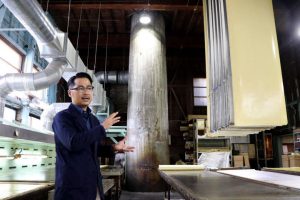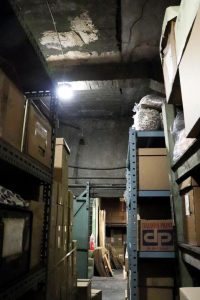Walking tour of A-bombed buildings—Warehouse, as well as workspace/smokestack, of Rekiseisha (in Hiroshima’s Nishi Ward) symbolize post-bombing recovery
Dec. 19, 2022
by Rina Yuasa, Staff Writer
Rekiseisha, a local company, in the area of Misasa-machi in Hiroshima’s Nishi Ward, produces gold leaf wallpapers used in interior decorating for luxurious hotels and art museums in Japan and overseas. In contrast to the company’s glamourous appearance, its history includes efforts to overcome devastation from the atomic bombing. The company warehouse is included in the list of A-bombed buildings registered with the Hiroshima City government.
The warehouse is a reinforced concrete structure once used as storage space for chemicals. It is still being used today as a storeroom.
“There is something we want people to look at more than the warehouse,” said Tomoyuki Hisanaga, 41, the sixth-generation president of Rekiseisha. And that is the workspace and its gymnasium-like atmosphere that he introduced one day recently. A concrete column standing in the interior space appears to poke through the ceiling. The column’s height is about 30 meters. Mr. Hisanaga explained, “This is a smokestack that withstood the atomic bombing.”
Rekiseisha was founded at its current location in 1905. The smokestack, used for the work of drying wallpaper, was visually conspicuous in the area at the time. On August 6, 77 years ago, the five-story headquarters building, located about 2.2 kilometers from the hypocenter, was completely burned to the ground. About 20 employees were wounded in the blast and two people died, including the founder’s wife. The warehouse and smokestack remained.
The smokestack structure in particular stands as a symbol of the company’s recovery from the memories and literal ruins of “that day.”
Several years ago, on a tour of the factory, a woman visitor apparently placed her arms around the smokestack and began crying in front of Mr. Hisanaga. She described how she had experienced the atomic bombing at her home in the same neighborhood, and the sight she first saw after regaining consciousness was the smokestack standing amid the ruins.
After the war ended, local residents gathered in the area and erected shacks to serve as residences. Rekiseisha was rebuilt by the sons of the founder, who was wounded in the bombing. In 1959, the company obtained the gymnasium and stairs of an elementary school located about 5.1 kilometers from the hypocenter, moved them to the area, and situated the structures around the smokestack and warehouse. Except for the warehouse, all the company’s other structures failed to meet the city’s criteria for registration as A-bombed buildings, defined as being “A-bombed buildings that still exist within five kilometers of the hypocenter.” Mr. Hisanaga said, “To us, the entire area here is made up of A-bombed buildings.”
The workspace and its smokestack have deteriorated, causing serious damage from leaking rain water. Seven years ago, the company planned anti-seismic renovations to protect against earthquakes, but the work was ultimately not done because the structural relocations and expansions complicated the work. Subsidies from the city government for repair of A-bombed buildings are only applicable to the warehouse. “We cannot continue to use these buildings as is,” said Mr. Hisanaga, as he struggles to find a way to maintain and pass on the assets to the next generation.
(Originally published on December 19, 2022)
Rekiseisha, a local company, in the area of Misasa-machi in Hiroshima’s Nishi Ward, produces gold leaf wallpapers used in interior decorating for luxurious hotels and art museums in Japan and overseas. In contrast to the company’s glamourous appearance, its history includes efforts to overcome devastation from the atomic bombing. The company warehouse is included in the list of A-bombed buildings registered with the Hiroshima City government.
The warehouse is a reinforced concrete structure once used as storage space for chemicals. It is still being used today as a storeroom.
“There is something we want people to look at more than the warehouse,” said Tomoyuki Hisanaga, 41, the sixth-generation president of Rekiseisha. And that is the workspace and its gymnasium-like atmosphere that he introduced one day recently. A concrete column standing in the interior space appears to poke through the ceiling. The column’s height is about 30 meters. Mr. Hisanaga explained, “This is a smokestack that withstood the atomic bombing.”
Rekiseisha was founded at its current location in 1905. The smokestack, used for the work of drying wallpaper, was visually conspicuous in the area at the time. On August 6, 77 years ago, the five-story headquarters building, located about 2.2 kilometers from the hypocenter, was completely burned to the ground. About 20 employees were wounded in the blast and two people died, including the founder’s wife. The warehouse and smokestack remained.
The smokestack structure in particular stands as a symbol of the company’s recovery from the memories and literal ruins of “that day.”
Several years ago, on a tour of the factory, a woman visitor apparently placed her arms around the smokestack and began crying in front of Mr. Hisanaga. She described how she had experienced the atomic bombing at her home in the same neighborhood, and the sight she first saw after regaining consciousness was the smokestack standing amid the ruins.
After the war ended, local residents gathered in the area and erected shacks to serve as residences. Rekiseisha was rebuilt by the sons of the founder, who was wounded in the bombing. In 1959, the company obtained the gymnasium and stairs of an elementary school located about 5.1 kilometers from the hypocenter, moved them to the area, and situated the structures around the smokestack and warehouse. Except for the warehouse, all the company’s other structures failed to meet the city’s criteria for registration as A-bombed buildings, defined as being “A-bombed buildings that still exist within five kilometers of the hypocenter.” Mr. Hisanaga said, “To us, the entire area here is made up of A-bombed buildings.”
The workspace and its smokestack have deteriorated, causing serious damage from leaking rain water. Seven years ago, the company planned anti-seismic renovations to protect against earthquakes, but the work was ultimately not done because the structural relocations and expansions complicated the work. Subsidies from the city government for repair of A-bombed buildings are only applicable to the warehouse. “We cannot continue to use these buildings as is,” said Mr. Hisanaga, as he struggles to find a way to maintain and pass on the assets to the next generation.
(Originally published on December 19, 2022)









